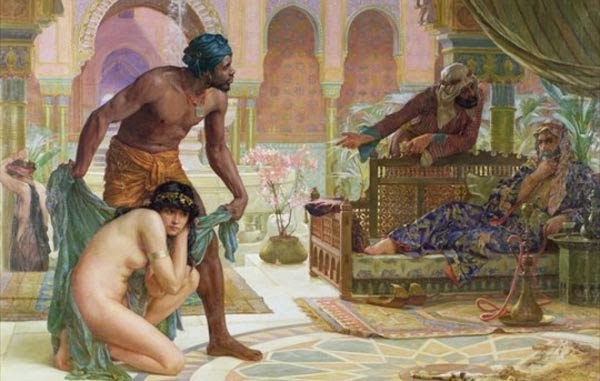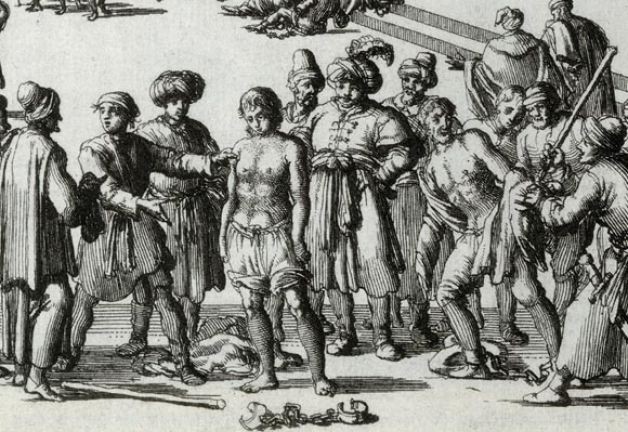While black Africans were loaded on ships to Europe and the Americas in the 16th and 17th century, Africans also engaged in slave trade that involved the purchase and humiliating torture of white captives. During that time, it was common to have white slaves in the markets of the Barbary Coasts awaiting purchase. About 1.2 million whites were held captive on African shores during this era, a tenth of the number of black Africans sold into slavery, but nonetheless, a significant amount.

The Barbary Coast
The Barbary Coast also known as the Berber Coast was in North Africa and swept across Morocco, Tunisia, Libya and Algeria. This area formed a part of the Ottoman Empire and was host to a multitude of Berber pirates and slave traders who held sway in the North Atlantic and Mediterranean Seas. They also engaged in raids of European coastal cities. This was also the scene of the Barbary Wars which witnessed United States’ first foreign land military operation, when Thomas Jefferson declared war on the Berber pirates which led to the end of piracy in that region. People in this region were majorly African Arabs.
The Barbary Corsairs & Slave Traders?
Barbary Pirates also known as Barbary Corsairs were involved in the captivity of European slaves and attacks on European coastal villages. However, just like African slave traders, the most prominent Barbary pirates were indeed European renegades, historian Adrian Tinniswood states. Most of them brought naval expertise to the piracy business. Among these were Henry Mainwaring, Captain Jack Ward, Sinan Reis, and Dragut. There were also a lot of Barbary natives, and Turkish descents who lorded the piracy and slavery business and these included The Barbarossa brothers, Mulai Ahmed er Raisuli, Salih Reis and so on.
These pirates caused terror in the seas, capturing sailors and seamen and selling them off into slavery. Attacks were launched on European and American ships. BBC reports that between 7000 and 9000 British men were taken into slavery by African pirates who plundered British Ships. It was also noted that the corsairs also raided coastal settlements and this was especially rampant in Baltimore, Ireland as well as Devon and Cornwall where British citizens were taken captive by Africans. Captives thus ranged from fishermen, sailors to coastal villagers and were mostly Christian and from impoverished families.

Other parts of Europe, Italy, Spain, France, Portugal, Netherlands, Sicily, Malta and as northwards as Iceland were raided by African pirates whose sole purpose was to capture European slaves. The 1500s witnessed continual attacks on these places and several thousands of slaves were captured each time.
What Happened To The Barbary Slaves?
Slaves were captured and made to stand in the town markets to be examined by potential buyers. Others were made to walk through town for auction. Professor Robert Davies, who authored the book Christian Slaves, Muslim Masters estimated that between 1-1.25 million white people were held in captivity by African slave traders. Several thousands of slaves however did not even make it to Africa and died in ships on voyages back to Africa.

Moroccan Slave Market. Anonymous woodcut (17th C.)
Slaves were usually held for a ransom. Thus many of the slaves whose families were not rich enough to buy their freedom immediately turned out at the slave markets for sale. Manual labour, housework, agricultural labour, construction works were examples of works awaiting white slaves bought at the auction. Women are usually sold into sexual slavery or become housemaids. Worst among these were the galley slaves who served in ships. A galley is a large ship propelled by oars or sails or both, that was used in ancient and medieval times, especially in the Mediterranean. They were the worst treated. A galley slave is usually forced to row a galley and could be confined to the galley for around 80-100 days in a year at sea. Slaves were not allowed to leave their seats while rowing the galley and had to eat, sleep, urinate and defecate at the same place they are bonded. A slave master cracks his whip on them anytime he senses complacency. And when off the sea, are made to join other slaves in hard labour.

Galley Workers
The Controversy Of Race And Religion
In its article titled the White Slaves of Barbary, Ancient Origins, it was stated that”
“In the 13th and 14th centuries, it was Christian pirates, primarily from Catalonia and Sicily that dominated the seas, posing a constant threat to merchants. It was not until the expansion of the Ottoman Empire in the 15th century that the Barbary corsairs started to become a menace to Christian shipping.”
Thus, events in this period may have had a religious undertone as just as Muslim African raiders plundered the soils of European geographies and took home captives, there were reprisal attacks by Christian Europeans who launched attacks on African Muslim soils and took home, thousands of Muslim captives as slaves too. The Knights of Saint Steven captured about 14,000 Muslims between 1568 and 1634, also notable were the Knights of Malta.
However, Robert Davis states in his BBC article British Slaves on the Barbary Coast:
“Slaves in Barbary could be black, brown or white, Catholic, Protestant, Orthodox, Jewish or Muslim. Contemporaries were too aware of the sort of people enslaved in North Africa to believe, as many do today, that slavery, whether in Barbary or the Americas, was a matter of race. In the 1600s, no one’s racial background or religion automatically destined him or her for enslavement. Preachers in churches from Sicily to Boston spoke of the similar fates of black slaves on American plantations and white slaves in corsair galleys; early abolitionists used Barbary slavery as a way to attack the universal degradation of slavery in all its forms”.
While there were widespread attacks on European shores, and also significant captures of European Christians, people in captive were not defined by a particular race or religion. It is not true that attacks were religiously or racially defined, stated Robert Davis in his book. People from almost every race, religion, culture or civilization have been made slaves by their own people and similarly enslaved by other people too.
[Header image]– Anglo-Dutch fleet in the bay of Algiers as support for the ultimatum demanding the release of white slaves on august 26 1816 (Nicolaas Baur, 1818)

